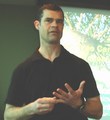FLASHBACK TO 2008: “The methodology embedded in the Water Balance Model powered by QUALHYMO enables a watershed target to be established," stated Kim Stephens at the concluding seminar in the Cowichan Valley Learning Lunch Seminar Series (July 2008)

“In 2002, ‘Stormwater Planning: A Guidebook for British Columbia’ articulated a principle that performance targets at the watershed scale provide a starting point to guide the actions of local government in the right direction,” stated Kim Stephens. “The objective is to translate those targets into appropriate site design criteria that then provide local government staff and developers with practical guidance for achieving the goal of stream protection.”










